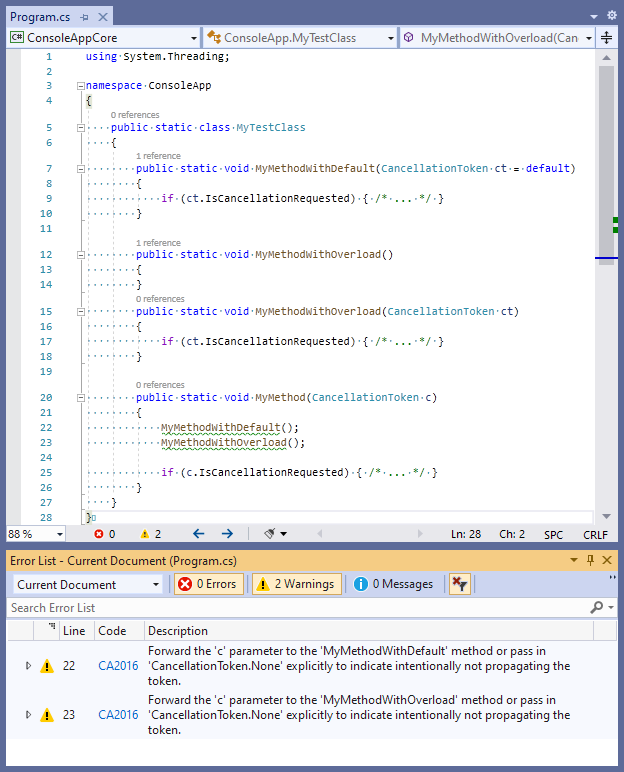CA2016:将 CancellationToken 参数转发到采用一个该参数的方法
| 属性 | 值 |
|---|---|
| 类型名称 | ForwardCancellationTokenToInvocations |
| 规则 ID | CA2016 |
| 标题 | 将 CancellationToken 参数转发到采用一个该参数的方法 |
| 类别 | 可靠性 |
| 修复是中断修复还是非中断修复 | 非中断 |
| 在 .NET 9 中默认启用 | 作为建议 |
原因
此规则查找可以接受 CancellationToken 参数但不传递任何参数的方法调用,并建议将父方法的 CancellationToken 转发给它们。
规则说明
此规则分析将 CancellationToken 作为其最后一个参数的方法定义,然后分析其主体中调用的所有方法。 如果任何方法调用可以接受 CancellationToken 作为最后一个参数,或者具有将 CancellationToken 作为最后一个参数的重载,此规则将建议改用该选项,以确保将取消通知传播到可以侦听它的所有操作。
注意
在 CancellationToken 类型可用的所有 .NET 版本中,规则 CA2016 都可用。 有关适用版本,请参阅 CancellationToken“适用于”部分。
如何解决冲突
可以手动修复冲突,也可以使用 Visual Studio 中提供的代码修复功能。 将出现的灯泡悬停在方法调用旁边并选择建议的更改。
下面的示例演示了两个建议的更改:

如果不关心是否将已取消的操作通知转发给下层方法调用,则可禁止显示此规则的冲突。 也可以在 C# 中显式传递 default(在 Visual Basic 中为 Nothing)或 None,以禁止显示规则冲突。
此规则可以检测各种冲突。 下面的示例演示了此规则可检测的情况:
示例 1
此规则建议将 c 参数从 MyMethod 转发到 MyMethodWithDefault 调用,因为该方法定义了一个可选的令牌参数:
using System.Threading;
namespace ConsoleApp
{
public static class MyTestClass
{
public static void MyMethodWithDefault(CancellationToken ct = default)
{
}
public static void MyMethod(CancellationToken c)
{
MyMethodWithDefault();
}
}
}
解决方法:
转发 c 参数:
public static void MyMethod(CancellationToken c)
{
MyMethodWithDefault(c);
}
如果不关心是否要将取消通知转发给下层调用,可以:
显式传递 default:
public static void MyMethod(CancellationToken c)
{
MyMethodWithDefault(default);
}
或显式传递 CancellationToken.None:
public static void MyMethod(CancellationToken c)
{
MyMethodWithDefault(CancellationToken.None);
}
示例 2
此规则建议将 c 参数从 MyMethod 转发到 MyMethodWithOverload 调用,因为该方法具有接受 CancellationToken 参数的重载:
using System.Threading;
namespace ConsoleApp
{
public static class MyTestClass
{
public static void MyMethodWithOverload()
{
}
public static void MyMethodWithOverload(CancellationToken ct = default)
{
}
public static void MyMethod(CancellationToken c)
{
MyMethodWithOverload();
}
}
}
解决方法:
转发 c 参数:
public static void MyMethod(CancellationToken c)
{
MyMethodWithOverload(c);
}
如果不关心是否要将取消通知转发给下层调用,可以:
显式传递 default:
public static void MyMethod(CancellationToken c)
{
MyMethodWithOverload(default);
}
或显式传递 CancellationToken.None:
public static void MyMethod(CancellationToken c)
{
MyMethodWithOverload(CancellationToken.None);
}
不冲突的示例
父方法中的 CancellationToken 参数不在最后位置:
using System.Threading;
namespace ConsoleApp
{
public static class MyTestClass
{
public static void MyMethodWithDefault(CancellationToken ct = default)
{
}
public static void MyMethod(CancellationToken c, int lastParameter)
{
MyMethodWithDefault();
}
}
}
默认方法中的 CancellationToken 参数不在最后位置:
using System.Threading;
namespace ConsoleApp
{
public static class MyTestClass
{
public static void MyMethodWithDefault(CancellationToken ct = default, int lastParameter = 0)
{
}
public static void MyMethod(CancellationToken c)
{
MyMethodWithDefault();
}
}
}
重载方法中的 CancellationToken 参数不在最后位置:
using System.Threading;
namespace ConsoleApp
{
public static class MyTestClass
{
public static void MyMethodWithOverload(int lastParameter)
{
}
public static void MyMethodWithOverload(CancellationToken ct, int lastParameter)
{
}
public static void MyMethod(CancellationToken c)
{
MyMethodWithOverload();
}
}
}
父方法定义了多个 CancellationToken 参数:
using System.Threading;
namespace ConsoleApp
{
public static class MyTestClass
{
public static void MyMethodWithDefault(CancellationToken ct = default)
{
}
public static void MyMethod(CancellationToken c1, CancellationToken c2)
{
MyMethodWithDefault();
}
}
}
具有默认值的方法定义了多个 CancellationToken 参数:
using System.Threading;
namespace ConsoleApp
{
public static class MyTestClass
{
public static void MyMethodWithDefault(CancellationToken c1 = default, CancellationToken c2 = default)
{
}
public static void MyMethod(CancellationToken c)
{
MyMethodWithDefault();
}
}
}
方法重载定义了多个 CancellationToken 参数:
using System.Threading;
namespace ConsoleApp
{
public static class MyTestClass
{
public static void MyMethodWithOverload(CancellationToken c1, CancellationToken c2)
{
}
public static void MyMethodWithOverload()
{
}
public static void MyMethod(CancellationToken c)
{
MyMethodWithOverload();
}
}
}
抑制警告
如果只想抑制单个冲突,请将预处理器指令添加到源文件以禁用该规则,然后重新启用该规则。
#pragma warning disable CA2016
// The code that's violating the rule is on this line.
#pragma warning restore CA2016
若要对文件、文件夹或项目禁用该规则,请在配置文件中将其严重性设置为 none。
[*.{cs,vb}]
dotnet_diagnostic.CA2016.severity = none
有关详细信息,请参阅如何禁止显示代码分析警告。
